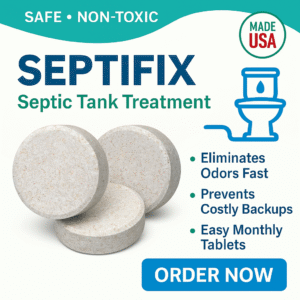Septic systems are expensive to install and maintain, and for many homeowners, the cost can feel overwhelming. Thankfully, there are federal, state, and local programs in the U.S. that provide grants or low-interest loans to help cover septic tank repair, replacement, or upgrades. If you’re wondering how to apply for a septic tank grant, this guide will walk you through the main options, eligibility requirements, and application steps. Plus, we’ll share some useful tools and products that can make your septic system last longer once you’ve secured funding.
Quick Picks
- USDA Rural Development Grant – Best Overall: offers grants and loans for septic repairs in eligible rural areas.
- EPA State Funding Programs – Best Budget: state-managed grants that provide direct financial assistance to households.
- HUD Community Development Block Grant (CDBG) – Best Premium: helps low-income homeowners cover septic system replacements as part of community projects.
Buyer’s Guide: Understanding Septic Grants
- USDA Grants: Available to very-low-income homeowners in rural areas. Can cover septic repair or replacement costs up to $10,000.
- EPA Programs: Many states administer septic repair funding through the Clean Water State Revolving Fund (CWSRF).
- HUD Block Grants: Distributed through local governments, often helping with septic replacements in low-income communities.
- State-Specific Grants: Some states like Florida, New York, and Maryland offer special funding for septic-to-sewer conversions or upgrades.
- Eligibility Factors: Household income, property location, and system condition usually determine grant approval.
How to Apply for a Septic Tank Grant
- Research available programs: Start with USDA, EPA, and HUD websites, then check your state’s health or environmental agency for septic funding programs.
- Check eligibility requirements: Income limits, rural residence, and property ownership are common conditions.
- Prepare documentation: You may need proof of income, property deed, system inspection reports, and cost estimates from licensed contractors.
- Submit your application: Apply online or through your local agency’s office. Deadlines and forms vary by program.
- Follow up: Grants may take weeks or months for approval. Keep in contact with your local agency for updates.
Detailed Program Reviews
USDA Rural Development Grant
Who it’s for: Rural homeowners with very-low incomes needing septic repair or replacement.
- Key Benefits: Grants up to $10,000; low-interest repair loans up to $40,000.
- Pros: Direct federal funding; widely available; covers major septic work.
- Cons: Rural-only; strict income limits.
Verdict: The best option for rural families struggling with septic repair costs.
EPA Clean Water State Revolving Fund (CWSRF)
Who it’s for: Homeowners in participating states seeking financial assistance for septic repairs.
- Key Benefits: Provides low-interest loans and grants; funds septic upgrades and repairs.
- Pros: State-administered; flexible funding options; widely used.
- Cons: Program availability varies by state.
Verdict: A strong option if your state participates in EPA septic funding programs.
HUD Community Development Block Grant
Who it’s for: Low-income households in eligible communities.
- Key Benefits: Covers septic system replacement as part of broader housing improvement programs.
- Pros: Federal funding distributed through local governments; supports disadvantaged homeowners.
- Cons: Not available everywhere; requires community-level approval.
Verdict: Ideal if your community participates in HUD development projects that include septic system funding.
State-Specific Septic Grant Programs
Who it’s for: Homeowners in states with environmental or health department septic initiatives.
- Examples: Florida’s Septic Upgrade Incentive Program, New York’s Septic Replacement Fund, and Maryland’s Bay Restoration Fund.
- Pros: Direct financial help for septic upgrades or replacements; targeted to local needs.
- Cons: Limited availability; funding caps may apply.
Verdict: Always check your state’s environmental agency for local septic grant opportunities.
Comparison Table
| Program | Funding Type | Eligibility | Application Link |
|---|---|---|---|
| USDA Rural Development | Grant up to $10k, loan up to $40k | Rural, very-low-income homeowners | Apply Here |
| EPA CWSRF | Low-interest loans, grants | Varies by state | Apply Here |
| HUD CDBG | Community grants | Low-income, community-based | Apply Here |
| State Programs | Varies (grants & incentives) | Depends on state law | Check State |
FAQ
1. Who qualifies for septic tank grants?
Eligibility depends on income, location, and system condition. Rural and low-income households often qualify.
2. Can grants cover full septic replacement?
Yes, some grants cover full replacement, but many only cover partial costs or specific upgrades.
3. How long does approval take?
Approval times vary by program, but most take several weeks to months.
4. Do I have to repay septic grants?
No, grants do not need to be repaid. However, loans or hybrid programs may require repayment at low interest.
5. Where do I start?
Begin with USDA, EPA, and HUD resources, then contact your local health or environmental agency for state-specific programs.
Conclusion
Septic tank grants can save homeowners thousands of dollars in repair and replacement costs. With options from USDA, EPA, HUD, and state-level programs, there are multiple pathways to financial assistance. If your system is failing or needs upgrading, applying for these grants is well worth the effort. Gather your documents, check your eligibility, and start with your local agency to find the best program for your home. With the right support, you can restore your septic system without draining your savings.
